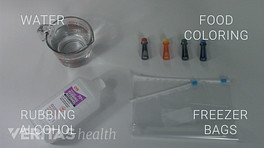Ice therapy is an easy, inexpensive, and surprisingly effective approach for pain relief. Applying ice can help ease pain by reducing inflammation, and is a useful tool for everyday pain management.
Ice is typically most effective when used shortly after pain begins. Many people find it beneficial to apply ice after activity or exercise, in order to calm swelling and reduce muscles spasms caused by overexertion. It can be helpful to keep a reusable cold pack on hand for regular pain flare-ups or muscle strains.
There are many kinds of cold packs sold in stores. In addition to standard gel or solid cold packs, you can find chemical packs that become cold once activated, usually by squeezing or shaking the pack; these can be useful to keep in a first aid kit or when traveling.
Additionally, you may wish to use different sorts of cold packs, and save money, by making your own from household items.
Dampening a sponge or hand towel in water, placing it inside a sealable freezer bag, and freezing is one simple example of a homemade ice pack. You may also try freezing a rice-filled sock. In a pinch, a bag of frozen fruits or veggies can be used.
You can also make cold packs similar to those sold in stores, such as a semi-flexible gel pack made by freezing liquid dishwashing soap in a freezer bag. Or, add 3 parts water and 1 part rubbing alcohol to a freezer bag, remove any excess air from the bag, and then place inside a second bag to avoid spills. This will freeze but remain malleable, which can be helpful for painful areas that are hard to cover.
Some people prefer an ice massage – gently working out muscle tension using an ice pack. To make a homemade ice massage applicator, fill a Styrofoam cup mostly full of water, freeze, then peel off the lip of the cup to access the ice’s surface. Apply to the painful area by slowly massaging in a gentle, circular motion for about 5 minutes at a time. Ice may be applied directly to the skin, because it will not be in contact with one area for very long.
Ice application has almost no risks. When using ice, there are a couple key guidelines to remember to obtain the best results and stay safe:
- Avoid applying ice directly to the skin. Doing so may cause mild frostbite – a type of skin damage commonly known as an “ice burn." Keep a layer of material, such as a hand towel, between your skin and the cold source whenever you use ice.
- Only apply ice or cold packs for a maximum of 15 to 20 minutes. Applying ice for longer may damage the skin.
When in pain, don’t forget about ice – it can be an effective tool for pain management, can be applied on a regular basis as needed, and can help you stay active and in better control of your pain.










